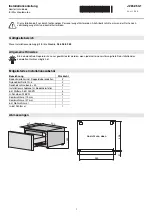
35
34
FIG. 7
11
12
22
21
Nm
12
FIG. 8
ABB. 5
Den Staubstreifer (14) schmieren und auf den
Gleitrohrscheitel legen.
WIEDERZUSAMMENBAU DES TAUCHROHRS
ABB. 6
Stecken Sie das Tauchrohr (13) vorsichtig und von der
Seite ohne Gewinde aus, in den Staubstreifer. Um den
Einführungsvorgang zu erleichtern und Schäden an
den Dichtungen zu vermeiden, das Tauchrohr drehen
und am Boden des Gleitrohrs auf Anschlag bringen.
Zum Prüfen der entsprechenden Lauffähigkeit, einige
Hubbewegungen mit dem Rohr ausüben. Das Rohr
muß frei, jedoch ohne Spiel, in der Dichtungsgruppe
laufen können. Falls Sie einen übermäßigen oder
einen zu geringen Widerstand erhalten, müssen Sie
die bis zu diesem Punkt beschriebenen Arbeiten
nochmals und sehr aufmerksam, wiederholen, dabei
sind auch die Elemente auf ihre Unversehrtheit hin zu
überprüfen.
WIEDEREINBAU DER HYDRAULISCHE
KARTUSCHE
ABB. 7
Den Gegenfeder (12) für den Endanschlag des Rück-
laufhubs in der hydraulische Kartusche einlegen. Mit
dem Tauchrohr am Endanschlag im Gleitrohr nun die
hydraulische Kartusche (11) komplett einführen.
ABB. 8
Den O-Ring (21) auf der Bodenmutter (22) fetten,
dann letztere auf den mit Gewinde versehenem
Ende der hydraulischen Kartusche anschrauben.
Auf einen Anzugsmoment von 12 Nm bringen.
Zum Prüfen des erfolgten Einbaus, nun das Tauch-
rohr einige Hubbewegungen ausführen lassen.
FIG. 5
Graisser le cache-poussière (14) et l'introduir du
haut du fourreau.
REMONTAGE DU PLONGEUR
FIG. 6
Introduire délicatement le plongeur (13) dans le
cache-poussière de la face non filetée. Afin de
rendre cette opération plus aisée, ainsi que d’évi-
ter d’endommager les éléments d’étanchéité, le
tourner et l'amener en butée sur le fond du four-
reau.
Faire réaliser au plongeur quelques courses d’es-
sai pour en vérifier le coulissement. Le plongeur
doit glisser librement à l’intérieur du sous-ensem-
ble étanche, mais sans jeu. Si l’on constate une
résistance trop importante ou son manque, effec-
tuer à nouveau les opérations décrites jusqu’ici
avec plus d’attention, en vérifiant l’intégrité des
composants.
REMONTAGE DE LA CARTOUCHE HYDRAU-
LIQUE
FIG. 7
Introduire l’élément en contre ressort (12) fin de
course en extension dans la cartouche hydrauli-
que. Le plongeur à fin de course dans le fourreau,
introduire la cartouche hydraulique (11) complète.
FIG. 8
Graisser le joint torique (21) sur l’écrou de fond
(22) et visser celui-ci sur l’extrémité filetée de la
cartouche hydraulique. Serrer au couple de 12
Nm. Faire réaliser quelques courses au plongeur
pour en vérifier le montage.
FIG. 5
Lubrificate il raschiapolvere (14) ed introducetelo
sulla sommità del fodero.
RIMONTAGGIO TUBO PORTANTE
FIG. 6
Introducete delicatamente il tubo portante (13) nel
raschiapolvere dal lato non filettato. Per agevola-
re l’operazione di inserimento ed evitare di dan-
neggiare le tenute ruotatelo e portatelo in battuta
sul fondo del fodero.
Fate fare al tubo qualche corsa di prova per
verificare lo scorrimento. Il tubo deve poter scor-
rere liberamente all’interno del gruppo di tenuta
ma senza gioco. Se riscontrate una resistenza
eccessiva o scarsa eseguite nuovamente le ope-
razioni fino ad ora descritte con più attenzione,
verificando l’incolumità degli elementi.
RIMONTAGGIO CARTUCCIA IDRAULICA
FIG. 7
Inserite la contromolla (12) di fine corsa del ritorno
nella cartuccia idraulica. Con tubo portante a
fondo corsa nel fodero introducete la cartuccia
idraulica (11) completa.
FIG. 8
Ingrassate l’anello OR (21) sul dado di fondo (22)
e avvitate quest’ultimo sull’estremità filettata della
cartuccia idraulica.
Serrate alla coppia di 12 Nm.
Fate fare qualche corsa al tubo portante per
verificare l’installazione.
FIG. 5
Lubricate the dust seal (14) and insert it into the
top of the slider.
STANCHION TUBE
FIG. 6
Insert the stanchion tube (13) gently into the dust
seal from the unthreaded side. Rotating and com-
pressing the stanchion tube simultaneously until it
has reached the bottom of its stroke in order to
have a smoother installation and not damage the
seals. Check to ensure that the stanchion tube
slides properly through its stroke by pumping it up
and down several times. The tube should move up
and down easily inside the seal assembly but
without having any play side to side. In the event
the movement is either restricted or too loose,
repeat the previous steps above and check all
components to see that they are not damaged.
HYDRAULIC CARTRIDGE
FIG. 7
Fit the rebound spring (12) into the hydraulic
cartridge. Insert the complete hydraulic cartridge
(11) by compressing the stanchion tube com-
pletely to the bottom of its stroke.
FIG. 8
Grease the O-ring (21) on the foot nut (22) and
screw the nut on the hydraulic cartridge threaded
end.
Tighten at 12 Nm.
Check to verify that the stanchion tube slides
properly through the stroke by pumping it up and
down several times.
14
FIG. 5
13
FIG. 6






































